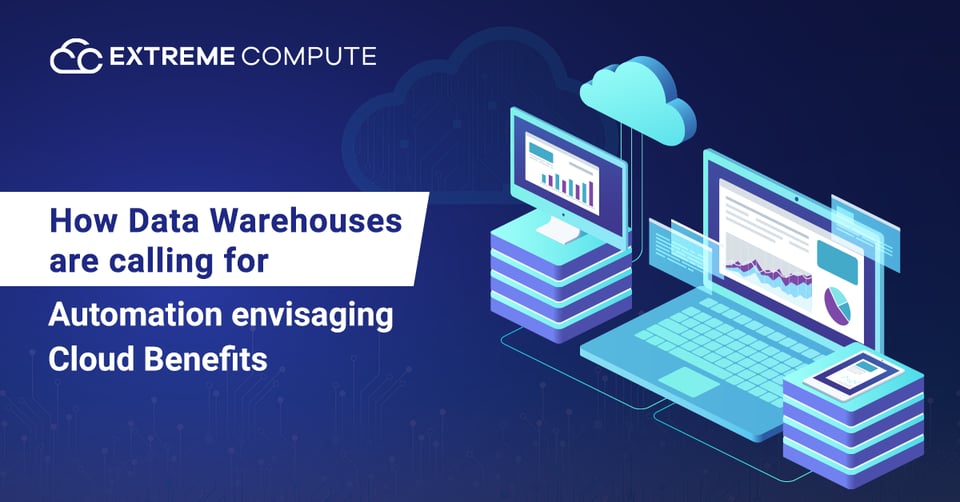How Data Warehouses are calling for Automation envisaging Cloud Benefits

As the economy becomes more volatile, companies would need to be more flexible in their activities and networks, as well as have infinitely variable technology costs. As everything moves to cloud these days, large enterprise data warehouses, which many believed would never abandon their on-premise data centers, are also migrating to the cloud in order to take advantage of today's cloud technology. Companies are gradually placing a higher value on data. Data is being seen as a valuable commodity by businesses. Even though data is important in decision-making, its importance is realized when it is processed, aggregated, and analyzed. This is where the data warehouse becomes more effective. The rise of cloud and automation is expected to be the future of data warehouse.
So What Exactly is a Data Warehouse?
A data warehouse is a form of data management system that is intended to facilitate and support business intelligence (BI) and analytics activities. Data warehouses hold vast volumes of historical data from which queries and analyses can be run. The data in a data warehouse is typically derived from a variety of sources, such as server log files and transaction applications. Surprisingly, a data warehouse consolidates and centralizes vast volumes of data from various sources. It aids in the improvement of decision-making by extracting useful market information from raw data. It accumulates a historical record over time that can be extremely useful to data scientists and business analysts. Furthermore, data warehousing refers to the method of creating and using a data warehouse. Cleaning, integrating, and consolidating data are also part of data warehousing. The following are some of the advantages of using a data warehouse:
- The source of the information gathered is crucial. The data warehouse helps you to link a data source to its database. This ensures that businesses obtain consistent and appropriate information from the source.
- Businesses do not have to be worried with data consistency because it is available or unreliable when it reaches the system. For better decision-making, this guarantees higher data quality and data transparency.
- The data warehouse's uniform format allows data to be analyzed at any time. It also makes use of the analytical resources and a larger dataset to make decisions based on hard data.
- Data is copied, stored, merged, annotated, summarized, and restructured in advance in a semantic data store at the data warehouse, making the analytics process easy.
- In addition, data warehouses allow organizations to analyze vast volumes of heterogeneous data and derive meaningful value from it in four ways: subject-oriented, integrated, non-volatile, and time-variant.
Data Warehouse Types
Today, three different types of data warehouses make a difference in the business process.
Enterprise Data Warehouse (EDW): An Enterprise Data Warehouse (EDW) is a relational data warehouse that houses a company's business data, such as customer details. Data analytics, which can lead to actionable observations, are made possible by an EDW. It also provides a cohesive approach to data organization and representation.
An Operational Data Store (ODS) is a central database that offers a snapshot of the most recent data from various transactional systems for operational reporting. It allows businesses to consolidate data in its original format from a variety of sources into a single location for business reporting.
A Data Mart is a subset of data collected in a data center that is based on a specific functional region of an enterprise. A data mart is a streamlined version of a data warehouse that is intended for use by a single department, unit, or group of users within a business.
The Data Warehouse is being moved to the Cloud
On-premise data warehouses offer a number of advantages, including better governance, security, and speed. They are not, however, elastic, and deciding how to structure the data warehouse for future needs necessitates complex forecasting. And during lockdown, the entire staff was moved to the cloud, including the data warehouse. Also large enterprise data warehouses, which many believed would never abandon their on-premise data centers, are migrating to the cloud in order to take advantage of today's cloud technology. The following are some of the benefits of using a cloud data warehouse:
- Different schema and data forms are supported by cloud data warehouses.
- It takes advantage of elasticity by segregating compute and storage.
- Organizations can segment their work phases and be prepared to recover from failures as part of their contingency planning to avoid the possibility of failure.
- A cloud data warehouse can scale up or down to meet computing or storage needs.
- They are simple to operate, have a flexible management system, and are cost-effective.
Data Warehouse: Automation and Cloud is the Future
Data integration, data views, data quality, optimization, competing methodologies, and so on are some of the problems that a data warehouse must deal with. Fortunately, data warehouse automation will fully turn this situation around. In data warehouse automation, the planning, modeling, and integration phases of the entire lifecycle are automated using next-generation technology that relies on advanced design trends and processes. To successfully migrate your data warehouse to the cloud, you must take small steps, particularly when making major design changes. You can keep using your on-premise data warehouse as your cloud data warehouse goes live if you take a gradual approach.

